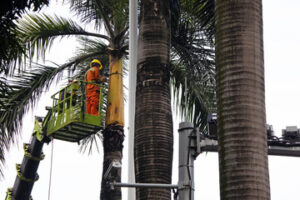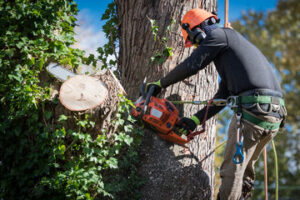Palm trees are a beautiful addition to any landscape. But they require regular pruning to maintain their beauty and health.

This includes removing dead fronds, hazardous limbs, and flowers or fruit. Before making any cuts, be sure to use rubbing alcohol to sanitize your tools. This will prevent the spread of disease to your tree. For professional help, contact Palm Tree Trimming Phoenix.
Palm trees are high-density plants, and their branches and limbs are heavy. They can pose serious safety threats during storms and heavy winds, and can cause property damage if they fall. A well-trimmed palm tree will help to keep these hazards at bay.
The first step in trimming a palm is to get to know your plant. This will help you determine when it is time to trim, and what to do during the process. For example, palms grow with a symmetrical shape, and pruning should accentuate this natural form rather than detract from it. Over-trimming can stress a palm, so it is best to start at the bottom and work your way up to avoid removing too many mature fronds.
Next, you will need to identify the tools that are necessary for the job. While a small palm may be satisfied with a cutting knife and pruning shears, larger trees will require more hardy equipment. In some cases, it may be necessary to bring in professional climbing equipment, such as a bucket lift or cherry picker. This is especially important when the tree is located near power lines or other structures, and it will help to minimize the risk of injury or damage during the trimming process.
After preparing the trimming equipment, it is best to prune in the early morning or late afternoon when the sun is not at its peak. This will minimize the stress on the plant and will also allow it to recover faster from the trimming process. It is also recommended to thoroughly clean all pruning equipment before and after each session, using diluted bleach, rubbing alcohol, or a commercial disinfectant. This will reduce the risk of spreading diseases from one plant to another.
Know Your Tools
Palm trees can be quite tall, and trimming them requires the use of a good set of tools. To begin with, you should pick up a pair of gloves and protective eyewear to prevent injuries during the process. You will also need a bucket to collect the debris. The next step is to inspect the tree to identify any fronds that need to be removed. It is important to look for fronds that are brown or broken, but be sure not to trim away yellowing or green fronds. It is also important to be careful not to remove any fronds near the trunk of the palm. To do so can cause stress to the tree and may even result in death.
Once you’ve done an inspection, the next step is to select the right tool for the job. For small fronds, a serrated knife or pruning shears should be sufficient. However, for larger fronds, a hand saw may be necessary. Finally, it is essential to keep your tools clean and sterile before and after each trimming session. This will help minimize the risk of spreading disease from one palm to another.
One of the biggest mistakes that can be made when trimming a palm is over-pruning it. Over-pruning can actually damage the tree by removing too many of its vital nutrients and causing it to enter a state of deficiency mode. It is also possible to damage the roots by removing too much soil.
The best way to avoid this is by using a professional palm tree service with extensive experience in the field. They will know how to balance the health of a palm with the aesthetics of its landscape, and they will be able to ensure that your tree is healthy, safe, and beautiful.
Know the Boundary Line
Palm trees are a beautiful addition to any landscape, but they require careful maintenance in order to thrive. Trimming is just one of the many ways you can protect and improve your tree’s health. But when it comes to trimming, it’s important to know where to draw the line. Over-trimming can lead to stress and detract from the beauty of the tree.
As with any garden project, it’s essential to use proper safety equipment when working with palm trees. This includes protective gloves, eyewear, and a hard hat. Using the right gear ensures that you’re protected from falling fronds or other debris and can focus on the task at hand.
It’s also crucial to understand the natural shape of your palm before you start trimming it. Some palms have a more symmetrical growth pattern, while others may lean towards the light. By understanding the natural shape of your palm, you can better ensure that your trimming will accentuate the beauty of the tree rather than detract from it.
The last thing you want to do is trim a palm too closely, as this can cause the tree to stress and possibly die. If you’re not sure where to draw the line, it’s best to consult a professional who can assess your palm and determine the ideal cutting point.
It’s also vital to be mindful of your surroundings, especially when trimming near power lines. Contact with these lines can result in severe injury or even death. If you’re not comfortable trimming your palms close to power lines, it’s best to hire a professional who can handle this delicate job safely.
Know When to Trim
The amount of fronds that are removed from a palm tree can have an impact on its health and appearance. For example, removing too many fronds during the summer can put the tree in “deficit mode” and affect its ability to produce food for new growth.
To prune correctly, begin by thoroughly assessing the entire tree and its health. Look for any dead fronds and petioles (blades of fronds) that need to be cut off, but avoid pruning healthy green fronds or those near the trunk. These fronds provide vital nutrients to the rest of the plant.
Additionally, be mindful of flowers and fruit stalks that may be forming, as these can redirect nutrients away from the main plant. For this reason, it’s important to trim any flowers or fruits that develop from the palm tree. This also helps to minimize the risk of falling debris and the attraction of pests.
Ultimately, if you’re unsure of how to properly trim your palm tree or if it’s too tall for you to safely reach, call in the professionals. These professionals can assess the health of your palm tree, recommend a course of action and ensure that your trees are trimmed correctly without causing damage to surrounding property or people.
Be sure to use safety equipment when trimming your palms, such as a pair of gardening gloves and protective eyewear. For smaller trees, a simple extension ladder might be adequate, but for more mature or taller specimens, professional climbing gear like a bucket lift or cherry picker is required. It’s also a good idea to disinfect your tools between palms to reduce the chance of disease transmission from one tree to another. Soaking your tools for 15 minutes in a 1:1 solution of a commercial tree cleaner and water should do the trick.
Clean Your Tools
As with any type of pruning, it’s vital to use clean tools. This helps ensure the cut heals properly and reduces the risk of disease. For palm trees, a sharp knife or pair of scissors will usually work well for smaller fronds. Larger fronds and flower stalks can be cut with shears or a pole saw, depending on the size of the tree. For safety, a hard hat and protective gloves should always be worn when trimming a palm tree.
Start by inspecting the tree to identify any dead or dying fronds, as well as those that are growing too close to buildings or power lines. It’s also important to consider the natural shape of the tree when deciding which fronds to trim. Over-trimming can weaken the tree by detracting from its symmetry. Avoid using the “hurricane cut,” which is when well-meaning gardeners trim down a palm like a topiary hedge – leaving it with a Marine-style high and tight look that actually stresses the tree.
It’s also a good idea to prune the lower fronds of the tree regularly, as these can become unsightly and overgrown. Also, be sure to remove any fruit that’s ripening, as this can attract pests and create hazards for people walking below the tree. Finally, don’t forget to dispose of the trimmed fronds properly. Leaving them on the ground can create a breeding ground for insects and pests and might even be a fire hazard. It’s best to place them in a trash bin that’s made for organic waste. This will keep them out of reach from children and pets who might mistakenly think they’re fun to play with.

